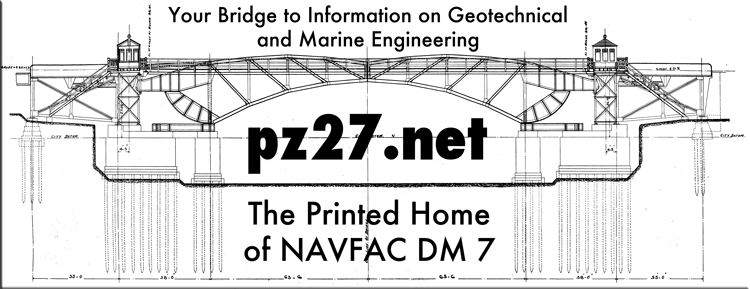|
|
U.S. Army TM 5-815-5
November 1983
This manual provides guidance for the planning, design, supervision, construction, and operation of dewatering and pressure relief systems and of seepage cutoffs for deep excavations for structures. It presents: description of various methods of dewatering and pressure relief techniques for determining groundwater conditions, characteristics of pervious aquifers, and dewatering requirements; guidance for specifying requirements for dewatering and seepage control measures; guidance for determining the adequacy of designs and plans prepared by contractors; procedures for designing, installing, operating, and checking the performance of dewatering systems for various types of excavations; and descriptions and design of various types of cutoffs for controlling groundwater. |
|
|
REMR Technical Note CS-ES-4.6
1996
One of the key stages in a stability evaluation of navigation and flood control structures is the calculation (or assignment) of uplift pressures along the base of the hydraulic structure and/or along a critical rock joint or joints within the foundation. Using accurate epizootic instrumentation data at a site along with knowledge of the site geology is the preferred method for establishing uplift pressures. However, when instrumentation data are not available or when the reservoir levels to be analysed exceed those for which the piezometric measurements were made, other procedures must be used to establish the distribution of flow and the corresponding uplift pressures. Three procedures are widely used by engineers to establish the uplift pressures along an imaginary section or sections through the structure-foundation interface and/or along a section or sections within the rock foundation. These three procedure are (1) a prescribed uplift distribution as given, for example, in an engineering manual specific to the particular hydraulic structure; (2) uplift pressures computed from flow within rock joints; or (3) flow-net-computed uplift pressures. |
|
|
Donald G. Jorgensen
Geological Survey Water-Supply Paper 2064
Department of the Interior
1980
The many varied though related terms developed by ground-water hydrologists and by soils engineers are useful to each discipline, but their differences in terminology hinder the use of related information in interdisciplinary studies. Equations for the Terzaghi theory of consolidation and equations for ground-water flow are identical under specific conditions. A combination of the two sets of equations relates porosity to void ratio and relates the modulus of elasticity to the coefficient of compressibility, coefficient of volume compressibility, compression index, coefficient of consolidation, specific storage, and ultimate compaction. Also, transient ground-water flow is related to coefficient of consolidation, rate of soil compaction, and hydraulic conductivity. Examples show that soilsengineering data and concepts are useful to solution of problems in ground-water hydrology. |
|
|
EM 1110-2-1901
30 April 1993
This manual presents the fundamental design principles and guidance concerning seepage considerations for design of new dams and the evaluation of existing projects.
All earth and rock-fill dams are subject to seepage through the embankment, foundation, and abutments. Concrete gravity and arch dams are subject to seepage through the foundation and abutments. Seepage control is necessary to prevent excessive uplift pressures, sloughing of the downstream slope, piping through the embankment and foundation, and erosion of material by loss into open joints in the foundation and abutments. The purpose of the project, i.e., long-term storage, flood control, etc., may impose limitations on the allowable quantity of seepage. |

